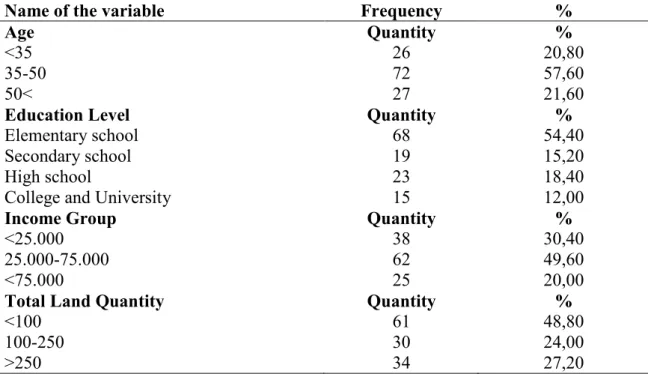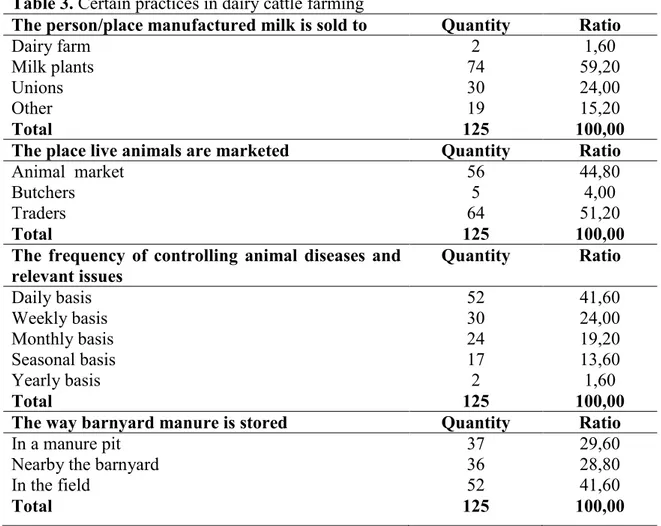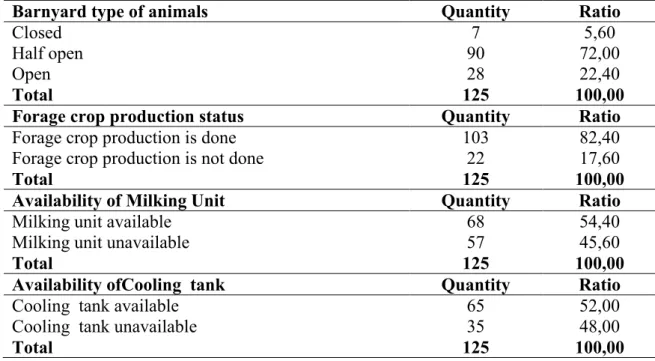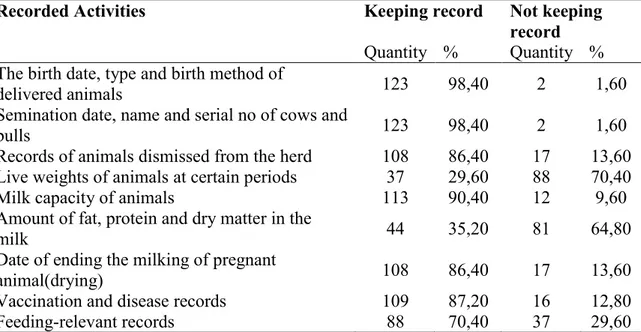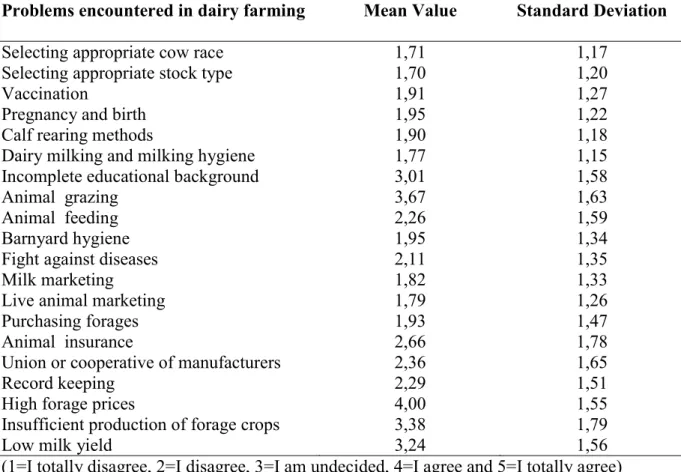*This paper has been compiled from the project outcomes of 15401020 no
Dairy Enterprises and Levels of Adaptation to Innovations" endorsed by Scientific Researches Project Coordinatorship(BAP).
Journal of Selçuk University Natural and Applied Science
STRUCTURE AND PROBLEMS OF DAIRY FARMS IN
Cennet OĞUZ a
SelcukUniversity, Faculty of AgricultureDepartment of AgriculturalEconomic, Konya, Turkey
Abstract
The primary purpose of this research was to determine problems encountered by dairy farms in Konya province and to develop solutions for these problems
was obtained through questionnaire technique from 125 dairy cattle enterprises which were determined with stratified random sampling method on a voluntary basis.
covered by this study included socio
practices, recent changes in the number of dairy animal sand their reasons, factors to be considered in milking, keeping farm records, and problems encountered in dairy farming.
In the region the most critical problems encountered in d
the high forage prices and absence of milk in cold chain. In order to develop dairy farming enterprise owners are required to produce forage crops on their own, integrate produced milk into the cold chain and lower forage pric
trainings to the enterprises from specialists (veterinaries, zoo
economists, agronomists) assigned from private or public sector, relevant seminars should be provided on animal husbandry, animal care, feeding, fight against diseases, milking and hygiene, record-keeping in enterprises, animal insurance, procurement of input under favorable conditions and marketing ideas.
Key words: Dairy farming, Socio
———
* Corresponding author. Tel.: +0-000-000-0000
aper has been compiled from the project outcomes of 15401020 no “Economic ActivityResults of Konya Province Dairy Enterprises and Levels of Adaptation to Innovations" endorsed by Scientific Researches Project
Journal of Selçuk University Natural and Applied Science
Online ISSN: 2147-3781w w w . j o s u n a s . o r g 5 ( 3 ) : 1 - 1 4 , 2 0 1 6
STRUCTURE AND PROBLEMS OF DAIRY FARMS IN THE CASE OF KONYA PROVINCE
Cennet OĞUZa* and Aysun YENER
, Faculty of AgricultureDepartment of AgriculturalEconomic, Konya, Turkey
The primary purpose of this research was to determine problems encountered by dairy farms in Konya province and to develop solutions for these problems. The data used in th
was obtained through questionnaire technique from 125 dairy cattle enterprises which were determined with stratified random sampling method on a voluntary basis.
covered by this study included socio-economic characteristics of farmers, management practices, recent changes in the number of dairy animal sand their reasons, factors to be considered in milking, keeping farm records, and problems encountered in dairy farming.
In the region the most critical problems encountered in dairy farming can be listed as the high forage prices and absence of milk in cold chain. In order to develop dairy farming enterprise owners are required to produce forage crops on their own, integrate produced milk into the cold chain and lower forage prices to reasonable costs. Furthermore by providing trainings to the enterprises from specialists (veterinaries, zoo-technicians, agriculture economists, agronomists) assigned from private or public sector, relevant seminars should be bandry, animal care, feeding, fight against diseases, milking and keeping in enterprises, animal insurance, procurement of input under favorable conditions and marketing ideas.
Dairy farming, Socio-economic, Konya.
0000 ; fax: +0-000-000-0000 ; e-mail: coguz@selcuk.edu.tr.
“Economic ActivityResults of Konya Province Dairy Enterprises and Levels of Adaptation to Innovations" endorsed by Scientific Researches Project
Journal of Selçuk University Natural and Applied Science
THE CASE OF KONYA
, Faculty of AgricultureDepartment of AgriculturalEconomic, Konya, Turkey
The primary purpose of this research was to determine problems encountered by dairy farms . The data used in the research was obtained through questionnaire technique from 125 dairy cattle enterprises which were determined with stratified random sampling method on a voluntary basis. The main subjects farmers, management practices, recent changes in the number of dairy animal sand their reasons, factors to be considered in milking, keeping farm records, and problems encountered in dairy farming.
airy farming can be listed as the high forage prices and absence of milk in cold chain. In order to develop dairy farming enterprise owners are required to produce forage crops on their own, integrate produced milk es to reasonable costs. Furthermore by providing technicians, agriculture economists, agronomists) assigned from private or public sector, relevant seminars should be bandry, animal care, feeding, fight against diseases, milking and keeping in enterprises, animal insurance, procurement of input under
Introduction
Husbandry has presently been an indispensable sector that can contribute to the national economy of developed and developing countries via creating high added-value to unit investment, and offering low-cost employment opportunities (İçöz, 2004). Developed countries can, thanks to agriculture and husbandry sectors, guarantee employment in their countries and secure themselves a sound place as exporters. Once a number of global countries are examined, it surfaces that in terms of dairy exportation, New Zealand independently manufactures 25% share of the globally exported milk; Australia manufactures 13% share of exported milk and the USA manufactures 7% share of exported milk. They were able to reach such ratios by supporting plant and animal production through smart and cost- effective policies (FAO, 2015). In the globe the significance of husbandry in agriculture has been studied in an extensive body of researches (Vallapureddy, 2013; Gandhiand Zhou, 2010; Upton, 2004; Alvarez et al., 2008; Rodríguez-Couso et al., 2006). As we closely investigate husband
ry sector in Turkey, we come across with the facts that dairy products hold a major significance for the sufficient and balanced nutrition of the national population and also for utilizing as an industrial raw material in a myriad of domains and for the economic development in rural parts (Parlakay et al., 2015). Nonetheless the high prices of inputs and the low prices of milk are identified as one of the most salient problems of the sector (Pryce &Veerkamp 2001; Horan et al., 2004; Evans et al., 2006). Enterprises that seek to boost their revenues and continue sustainability can overcome such challenges by increasing the efficiency of their inputs (Farell, 1957). Relevant studies on the same subject dealt with dairy sector's problems on national and regional scales and suggested a myriad of solutions to implement (Şahin et al., 2001; Koyubenbe, 2005; Öztürk and
Karkacıer,2008; Yalçın, 2008; Kaygısız&Tümer, 2009a; Kaygısız&Tümer, 2009b; Boz et al., 2011; Yener&Oğuz, 2014).
Hence the primary purpose of this research is to determine the problems encountered by dairy farms in Konya province and to develop solutions for these problems.
Materials and Methods
The main material of the study consists of original data collected through questionnaires from dairy cattle enterprises in Konya, which is selected as the research region. Furthermore, some data were obtained from previous studies made by various institutions and organizations on this subject. The data in the study contain the production period 2015-2016 and the questionnaires are filled by the researcher. In the study Ereğli, Karapınar and Çumra districts meeting 36,45% of milk production and 33,88% of animal quantity in Konya province were selected purposefully.
In order to increase the accuracy of findings collected from enterprises and ensure adequate representation of different parts of population, stratified sampling method was used in the research (Yamane, 1967; Güneş&Arıkan, 1985). Sample size is calculated as 125 within 99% confidence interval and with 5% error margin and the enterprises in sample size were selected randomly on the basis of voluntariness (Table 1).
Table 1. Sample size in research region
Enterprise Size Groups (decare) Sample Size (Count)
0-50 72
51-150 38
151-+ 15
Total 125
Problems encountered in dairy farming were computed via 5 point Likert-type scale. Scaling was graded from 1= I totally disagree to 5= I totally agree (Köklü 1995). Data collected from dairy farming enterprises were transferred to applicable statistical programs and descriptive statistics consisting of frequency, percentage, mean and
standard deviation to devise essential tables were formed and then interpreted in line with research objectives.
Results
Data collected to manifest the problems of dairy farming enterprises are as listed in Chart 2. In this study as the socio-economic features of dairy enterprises are examined it surfaces that of all the enterprise owners in dairy farming sector analyzed, 20,80% belong to age 0-34 group; 57,60% belong to age 35-50 group and 21,60% belong to age 50 and above. Mean age of owners in dairy farming sector was computed as Mean Age = 43,42, Standard Deviation (SD) =10,26. In sum it can be claimed that enterprise owners in terms of age criteria belong to active population. In relevant literature, age distribution was designated to be between age group 30-50 (Boz, 2013; Demir et al., 2013). With respect to education level, 54,40% of enterprise owners are elementary school graduates; 15,20% are secondary school graduates; 18,40% are high school graduates and 12% are college-university graduates. 49,60% of enterprise owners are from middle income group; 30,40% of enterprise owners are from low income group and 20% of enterprise owners are from high income group. As the enterprises are examined with respect to land size, 48,80% are smaller than 100 decare; 24% are between 100-250 decare and 27,20% are larger than 250 decare. Mean value of estate land size of all enterprises was computed as 183,77decare (SD=276,90). In terms of husbandry sector, it is important that enterprise land is above the mean value of Turkey (…).88,39% of enterprises are estate lands; 11,61% are rental lands. The wide portion in estate land indicates that in research region land capital also constitutes a high portion within the capital segment of enterprises. Personal features of enterprise owners (age, education, experience etc.) and general characteristics of enterprises (size of enterprise,
benefiting from state support, production technique, number of household, access to information resources etc.) render critical effect on the economic activity results of enterprises (Latrüffe et al., 2004; Moreira Lopez et al., 2006; Pöldaru& Roots, 2009; Cabrera et al., 2010 Gündüz, 2011).
Table 2. Socio-Economic Features of Dairy farming Enterprise owners and Descriptive Statistics
Name of the variable Frequency %
Age Quantity %
<35 26 20,80
35-50 72 57,60
50< 27 21,60
Education Level Quantity %
Elementary school 68 54,40
Secondary school 19 15,20
High school 23 18,40
College and University 15 12,00
Income Group Quantity %
<25.000 38 30,40
25.000-75.000 62 49,60
<75.000 25 20,00
Total Land Quantity Quantity %
<100 61 48,80
100-250 30 24,00
>250 34 27,20
A few of the practices implemented in dairy farming enterprises are as displayed in Table 3. In the dairy farming enterprises analyzed, the person/place manufactured milk is sold to, the place live animals are marketed, the frequency of controlling animal diseases and relevant issues, the way barnyard manure is stored, barnyard type of animals, forage crop production status, availability of milking unit and availability of cooling tank were examined. 59,20% of enterprises sell the manufactured milk to milk plants; 24% sell the manufactured milk to milk producers' union, 15,20% of enterprises sell the manufactured milk to other companies and 1,60% of enterprises process the milk in their own dairy farm. 51,20% of live animals are sold to traders; 44,80% are sold in animal market and 4% are sold to the butchers. 41,60% of participating
enterprises controlled animal diseases on a daily basis, 24% on a weekly basis, 19,20% on a monthly basis, 13,60% on a seasonal basis and 1,60% on a yearly basis. 41,60% of yielded barnyard manure is collected in their own land; 29,60% is collected in a manure pit and 28,80% is collected nearby the barnyard. 72% of barnyards is half-open; 22,40% is open and 5,60% is close barnyard. 82,40% of enterprises manufacture forage crop but because forage crop production is less than sufficient they favor to purchase foods from external sources. As reported by Konya dairy commission (2010), it was declared to be vital in dairy farming enterprises to grow coarse forage plants in an average of 3 decare zone per animal, and to lower dairy expenses for the aim of ensuring enterprises' sustainability. In the research region, 54% of enterprises had a milking unit, and 52% of enterprises had a cooling tank.
Table 3. Certain practices in dairy cattle farming
The person/place manufactured milk is sold to Quantity Ratio
Dairy farm 2 1,60
Milk plants 74 59,20
Unions 30 24,00
Other 19 15,20
Total 125 100,00
The place live animals are marketed Quantity Ratio
Animal market 56 44,80
Butchers 5 4,00
Traders 64 51,20
Total 125 100,00
The frequency of controlling animal diseases and relevant issues Quantity Ratio Daily basis 52 41,60 Weekly basis 30 24,00 Monthly basis 24 19,20 Seasonal basis 17 13,60 Yearly basis 2 1,60 Total 125 100,00
The way barnyard manure is stored Quantity Ratio
In a manure pit 37 29,60
Nearby the barnyard 36 28,80
In the field 52 41,60
Barnyard type of animals Quantity Ratio
Closed 7 5,60
Half open 90 72,00
Open 28 22,40
Total 125 100,00
Forage crop production status Quantity Ratio
Forage crop production is done 103 82,40
Forage crop production is not done 22 17,60
Total 125 100,00
Availability of Milking Unit Quantity Ratio
Milking unit available 68 54,40
Milking unit unavailable 57 45,60
Total 125 100,00
Availability ofCooling tank Quantity Ratio
Cooling tank available 65 52,00
Cooling tank unavailable 35 48,00
Total 125 100,00
In the research region the latest changes in dairy cattle quantity and explanatory reasons of the change are givenin table 4. Of all the investigated enterprises, there was a decrease in animal quantity in 22,40% of enterprises, whilstnot a significant change was measured in 77,60% of enterprises. The reasons in the decrease of animal quantities as per manufacturers are as demonstrated in five-point Likert scale (Table 4). The overall tendency of enterprises pointed to the high prices of crops as the main reason (4.68/5), and low prices of milk (4.54/5). In addition, lowness of investment capital (3.89/5) and insufficiency of state support for dairy farming are the accompanying reasons in the decrease of animal quantity.
Table 4. The Latest Change Trends in the Possessed Quantity of Dairy Cattles The Latest Change status in dairy cattle
quantity
Quantity %
A decrease observed 28 22,40
Not a significant change observed 97 77,60
Total 125 100,00
Reasons for the decrease in dairy cattle quantity
Mean value
Standard Deviation
Decrease in meadow-forage lands 2,68 1,81
Low milk prices 4,54 0,79
Insufficiency of state support for dairy farming 3,82 1,59
Unregistered animals 2,79 1,66
Low investment capital 3,89 1,50
High costs of dairy farming business 3,00 1,78
High costs of crop prices 4,68 0,77
Other (………) 2,54 1,95
(1=I totally disagree, 2=I disagree, 3=I am undecided, 4=I agree and 5=I totally agree)
The issues that enterprises are required to pay heeds to in dairy farm milking are as detailed in Table 5 and manufacturer tendencies are measured via five-point Likert Scale. It is identified that in the research region manufacturers abode by hygiene rules (4.58/5), and were attentive to follow udder cleaning and disinfection process during milking (4.63/5), before milking (4.52/5) and after milking (4.43/5), and cautious to maintain the cleaning and care of milking machines (4.62/5).
Table 5. Issues to Pay Heeds to in Dairy Milking
Practices in Dairy Milking Mean value Standard
Deviation
Milker's adherence to follow hygiene rules 4,58 0,79
Adherence to follow the milking order 4,63 0,59
Udder cleaning and disinfection before milking
4,52 0,71
Udder cleaning and disinfection after milking 4,43 0,98
Feeding that would, after milking, keep the animal standing till mammary duct closed
4,46 0,79
Cleaning and maintenance of milking machines
4,62 0,62
(1=I totally disagree, 2=I disagree, 3=I am undecided, 4=I agree and 5=I totally agree)
In the research region record keeping practices of manufacturers are as displayed in Table 6. Saving enterprise records poses value to ensure the sustainability of activities. It is easier to monitor current structure and time-dependant changes of the record-keeping enterprises and to spot the existing problems. Record-record-keeping procedure also positively contributes to provide key data for enterprise plans, to prepare individualized credit projects for the enterprise, to accurately calculate enterprise's actual income level and tax assessment, to build owner and leaser/partner relations on a much fairer basis in
the event that agricultural activity is related to partnership or tenantry system. On a national policy level, recordkeeping provides valuable contributions to obtain key data in agriculture-policy formation (İnan 2001; Karagölge 2001).
Table 6. Record keeping status in dairy farming activities
Recorded Activities Keeping record Not keeping
record Quantity % Quantity % The birth date, type and birth method of
delivered animals 123 98,40 2 1,60
Semination date, name and serial no of cows and
bulls 123 98,40 2 1,60
Records of animals dismissed from the herd 108 86,40 17 13,60
Live weights of animals at certain periods 37 29,60 88 70,40
Milk capacity of animals 113 90,40 12 9,60
Amount of fat, protein and dry matter in the
milk 44 35,20 81 64,80
Date of ending the milking of pregnant
animal(drying) 108 86,40 17 13,60
Vaccination and disease records 109 87,20 16 12,80
Feeding-relevant records 88 70,40 37 29,60
In the research region the records that enterprises kept on dairy farming provided information on the birth date, type and birth method of delivered animals animal; semination date, name and serial no of cows and bulls equaled to 98.40%, milk capacity of animals equaled to 90,40%, Vaccination and disease records equaled to 87,20%, animals dismissed from the herd and animal drying equaled to 86,40%, feeding status equaled to 70,40%, amount of fat, protein and dry matter in the milk equaled to 35,20%, live weight rises in animals at certain periods have been measured as 29,60% (Table 6). In research region manufacturers consider themselves experienced in dairy farming and the greatest problem they have to cope with is high forage prices (4/5). The other problems are listed as insufficient production of forage crops (3.38/5), absence of grazing fields for the animal (3.67/5), incomplete educational background on dairy farming (3.01/5). On the other hand manufacturers do not encounter significant
problems in the matters of calf rearing, pregnancy and delivery of calf, fight against diseases, dairy milking and barnyard hygiene (Table 7).
Table 7. Level of Significance of the Problems Manufacturer encounter in Dairy farming
Problems encountered in dairy farming Mean Value Standard Deviation
Selecting appropriate cow race 1,71 1,17
Selecting appropriate stock type 1,70 1,20
Vaccination 1,91 1,27
Pregnancy and birth 1,95 1,22
Calf rearing methods 1,90 1,18
Dairy milking and milking hygiene 1,77 1,15
Incomplete educational background 3,01 1,58
Animal grazing 3,67 1,63
Animal feeding 2,26 1,59
Barnyard hygiene 1,95 1,34
Fight against diseases 2,11 1,35
Milk marketing 1,82 1,33
Live animal marketing 1,79 1,26
Purchasing forages 1,93 1,47
Animal insurance 2,66 1,78
Union or cooperative of manufacturers 2,36 1,65
Record keeping 2,29 1,51
High forage prices 4,00 1,55
Insufficient production of forage crops 3,38 1,79
Low milk yield 3,24 1,56
(1=I totally disagree, 2=I disagree, 3=I am undecided, 4=I agree and 5=I totally agree) Discussion
In the region enterprise owners in dairy farming sector are from age group 35-50 in sum; elementary school graduates in general and have an average annual income level between 25.000-75.000 TL. In this province, enterprise land on average is smaller than 100 decare and owners possess mixed race and crossbred animals. Irrespective of sufficient forage crop support from the state, production level is still below expected level in the research region. In dairy farming, coarse and opaque forage greatly matters for the feeding of animals. 82,40% of enterprises manufacture forage crops. However the amount of manufactured forage falls short in meeting the needs of enterprises and
forage is procured from external sources. Periodic trainings should be provided for the development of manufacturers on topics such as care of the animal and preparing ration for the feeding of animals, forage crop growing and good practices should be explained on site. High price of forage is one of the most significant problems that manufacturers dealt with. Particularly among the enterprises that procure forage from external sources, instability of forage prices elevates the risk of closing down the enterprises. Enterprises that manufacture coarse and opaque forage on their own can lower their production expenses and become resistant against potential risks and voids. Another common complaint among manufacturers is the lowness of milk prices. A positive connection is detected between cold chain and milk prices. Once the milk manufactured by enterprises is put into cold chain, a major contribution to the income of enterprises is achieved. To that end certain associations such as dairy unions and cooperative organizations should be encouraged to install milk cooling tanks to villages. Ministry of Food, Agriculture and Livestock has recently taken major steps to prevent the fall in milk prices, but as a long-term permanent solution manufacturers should be offered trainings on forage crop production, ration preparation, care and feeding of the animal, hygiene, milking techniques, fight against animal diseases, record keeping, animal insurance, procurement of input under favorable conditions, effective marketing and good practices should be observed on site. The reason to suggest on-site observation is that manufacturers are better able to adopt and practice the techniques they personally view. Furthermore husbandry enterprises must decisively be encouraged to coordinate with agriculture advisors. It can thus become feasible to continuously monitor the activities of enterprises and solve the problems on site.
References
Alvarez, C. J., Riveiro, J. A. &Marey,M. F. (2008). Typology, Classification and Characterization of Farms for Agricultural Production Planning. Spanish Journal
of Agricultural Research, 6(1): 125-136.
Boz, I., Akbay, C., Budak, D. B. &Baş, S. (2011). Adoption of Innovations and Best Management Practices Among Dairy Farmers in the Eastern Mediterranean Region of Turkey. Journal of Animal and Veterinary Advances, 10(2): 251-261. Boz, İ. 2013. Structure, Problems and Solution Suggestions for the Dairy farming
Enterprises in Eastern Mediterranean Region of Turkey.
KahramanmaraşSütçüimam University, Natural Sciences Journal, 16(1).
Cabrera, V. E.,Solís, D. & Del Corral, J. (2010). Determinants of Technical Efficiency among Dairy Farms in Wisconsin. Journal of Dairy Science, 93 (1): 387-393. Demir, P., Aral, Y. &Sarıözkan S. (2013). Socio-Economic Structure and Production
Costs of Kars Province Dairy Cattle Raising Enterprises. YYU Faculty of
Veterinary Journal, 2014, 25 (1), 1 - 6 ISSN: 1017-8422; e-ISSN: 1308-3651.
Evans, R. D., Dillon, P., Buckley, F., Berry, D. P., Wallace, M., Ducrocq, V. &Garrick, D. J. (2006). Trends in milk production, fertility and survival of cows in 14 Irish dairy herds as a result of the introgression of Holstein-Friesiangenes. Animal
Science, 82 423–433.
FAO, 2015. http://www.fao.org/home/en/ (accessed date: 07/04/2016).
Farrell, M. J. 1957. The measurement of productive efficiency. Journal of The Roy.
Stat. Soc. Series A, III, p. 253-290.
Gandhi, V.P. & Zhou, Z. (2010). Rising Demand for Livestock Products in India.
Review Literature And Arts Of The Americas, 18, pp. 103-135.
Gündüz, O. (2011). Technical Efficiency in Dairy farming: Stochastic Activity Border Approach. Harran University Faculty of Agriculture Journal, 15(1)11-20, Şanlıurfa.
Güneş, T. &Arıkan, R. (1985). Agricultural Economics Statistics. Ankara University
Faculty of Agriculture Journal. No: 924. Ankara.
Horan, B., Mee, J. F, Rath, M., O’Connor, P. & Dillon, P. (2004). The effect of strain of Holstein-Friesiancow and feed system on reproductive performance in seasonal calving milk production systems. Animal Science 79 453–469
İçöz, Y. (2004). Profitability and efficiency analysis of Bursa city dairy farming enterprises. Issue No: 116, Ankara.
İnan, İ. H. (2001). Agricultural Economy and Management. TrakyaUniversity Faculty
of Agriculture Department of Agricultural Economics, 5. Ed. Tekirdağ.
Karagölge, C. (2001). Agricultural Enterprise. Atatürk University Faculty of
Agriculture Ofset Facilities Erzurum, p. 139.
Kaygısız, A. &Tümer, R. (2009a). Structural Features of Kahramanmaraş Province Dairy cattle Enterprises: 2. Barnyard Features. KSÜ Natural Sciences Journal., 12(1): 40-47.
Kaygısız, A. &Tümer, R. (2009b). Structural Features of Kahramanmaraş Province Dairy cattle Enterprises: 3. Animal Feeding Habits. KSÜ Natural Sciences
Journal., 12(1): 48-52.
Koyubenbe, N. (2005). A research on the ways of Developing Dairy farming Animal Production in İzmir City Ödemiş District., 46(1):8-13.
Köklü, N. (1995). Attitude Measurement and Options to Use in Likert Type Scales.
Ankara University Faculty of Educational Sciences Journal, vol:28, no:2,
p:89-90, Ankara. http://dergiler.ankara.edu.tr/dergiler/40/486/5698.pdf
Latruffe, L.,Balcombe, K., Davidova, S. &Zawalinska, K. (2004). Determinants of Technical Efficiency of Crop and Livestock Farms in Poland. Applied Economics, 36 (12):1255–1263.
MoreiraLópez, V. H., Bravo-Ureta, B. E., Arzubi, A. &Schilder, E., (2006). Multi output Technical Efficiency for Argentinean Dairy Farms Using Stochastic Production and Stochastic Distance Frontiers with Unbalanced Panel Data.
EconomíaAgraria, 10:97-106.
Öztürk, D.,Karkacıer, O. (2008). Economic Analysis of Dairy farming Enterprises Case of Tokat Province Yeşilyurt District. GOÜ. Faculty of Agriculture Journal, 25 (1), 15-22.
Parlakay, O., Semerci, A. &Çelik, A. D.(2015). Estimating technical efficiency of dairy farms in Turkey: a case study of Hatay Province. Custos e @gronegócio on line - v. 11, n. 3 – Jul/Sep - 2015. ISSN 1808-2882.
Põldaru, R. &Roots, J.(2009). Modeling Milk Cost in Estonia: A Stochastic Frontier Analysis Approach. http//:www.eau.ee/~aps/pdf/20091/poldaru.pdf, (access date: 10.04.2016).
Pryce, J. E. &Veerkamp, R. F.(2001). The incorporation of fertility indices in genetic improvement program in Fertility in the High Producing Dairy Cow. Diskin M G
ed. Midlothian, Scotland: British Society of Animal Science, Occasional
Publication 26 237–249.
Rodríguez-Couso, M.,Teijido, M. & C. Álvarez, J. (2006). Rural Development in Galicia (northwest Spain). Outlook on Agriculture, 35 (3): 183-189.
Şahin, K., Gül, A., Koç, B. &Dağıstan, E. (2001). In Adana Province Intensive Dairy farming Production Economy. YüzüncüYıl University, Faculty of Agriculture
Agricultural Sciences Journal (J. Agric. Sci.), 11(2):19-28.
Upton, M. (2004). The Role of Livestock in Economic Development and Poverty Reduction. Pro-Poor Livestock Policy Initiative Working Paper 10, FAO, Rome, Italy. http://www.fao.org/ag/pplpi.html
Vallapureddy, M. (2013). Dr.MuraliVallapureddy (2013) Socio Economics Aspects of The Women Dairy Farmers in A.P. Indian Economic Review, 22(1): 45-48.
Yalçın, C. (2008). Herd Health and Disease Management in terms of Economy in Diary Farming Enterprises. Aktüel, 79(1): 24-30.
Yamane, T. (1967). Elementary Sampling Theory.Prentice-Hall Inc. Englewood Cliffs, New Jersey.
Yener, A. &Oğuz, C. (2013). The Results of the Economic Activities of Dairy Farms in Konya-Eregli Province. International Journal of Technical Research and
Applications e-ISSN: 2320-8163, www.ijtra.com Special Issue 11 (Nov-Dec 2014), PP. 01-03.
